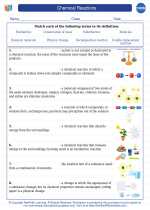High School Chemistry: The Environment
Welcome to the study guide for the topic "environment" in high school chemistry. This topic covers the impact of chemical reactions and substances on the environment, as well as the ways in which chemistry can be used to address environmental issues. Here's a detailed look at the key points you should understand.
Overview of Environmental Chemistry
Environmental chemistry is the study of chemical processes occurring in the environment which are impacted by human activities. It involves understanding the behavior of pollutants and their effects on both natural ecosystems and human health. As a high school chemistry student, it's important to grasp the following concepts:
Chemical Pollution
Chemical pollution occurs when chemicals are released into the environment, leading to negative impacts on ecosystems and human health. Common sources of chemical pollution include industrial waste, agricultural runoff, and emissions from vehicles and factories.
Acid Rain
Acid rain is a type of chemical pollution that occurs when sulfur dioxide and nitrogen oxides are released into the atmosphere and react with water, oxygen, and other chemicals to form acidic compounds. This can have detrimental effects on soil, water bodies, and vegetation.
Ozone Depletion
Ozone depletion refers to the thinning of the ozone layer in the Earth's stratosphere, primarily caused by the release of chlorofluorocarbons (CFCs) and other ozone-depleting substances. This can lead to increased exposure to harmful ultraviolet (UV) radiation from the sun.
Chemistry and Environmental Solutions
Chemistry plays a crucial role in developing solutions to environmental issues. As a high school student, it's important to understand how chemical principles can be applied to address environmental challenges. Some key areas to focus on include:
Green Chemistry
Green chemistry focuses on designing chemical products and processes that reduce or eliminate the use and generation of hazardous substances. This involves the use of sustainable and environmentally friendly practices in industries and research.
Environmental Remediation
Environmental remediation involves the use of chemical techniques to remove or neutralize pollutants in soil, water, and air. This can include methods such as phytoremediation, chemical oxidation, and bioremediation to clean up contaminated environments.
Alternative Energy Sources
Chemistry contributes to the development of alternative energy sources, such as solar cells, fuel cells, and biofuels. Understanding the chemical processes involved in these energy technologies is crucial for addressing the impact of fossil fuel consumption on the environment.
Study Tips
To excel in understanding the relationship between chemistry and the environment, consider the following study tips:
- Review the basic principles of chemical reactions and equilibrium, as they are fundamental to understanding environmental chemistry.
- Stay updated on current environmental issues and the role of chemistry in addressing them. This can include reading scientific articles, news reports, and case studies.
- Engage in hands-on experiments related to environmental chemistry, such as testing water quality or investigating the effects of pollutants on plant growth.
- Discuss and debate the ethical and social implications of chemical pollution and environmental degradation, encouraging critical thinking and awareness.
By mastering the concepts of environmental chemistry and its applications, you'll be well-equipped to appreciate the impact of chemistry on the world around you and contribute to sustainable solutions for the future.
.◂Chemistry Worksheets and Study Guides High School. Chemical Reactions

 Worksheet/Answer key
Worksheet/Answer key
 Worksheet/Answer key
Worksheet/Answer key
 Worksheet/Answer key
Worksheet/Answer key
 Worksheet/Answer key
Worksheet/Answer key
 Worksheet/Answer key
Worksheet/Answer key
 Vocabulary/Answer key
Vocabulary/Answer key
 Vocabulary/Answer key
Vocabulary/Answer key
 Vocabulary/Answer key
Vocabulary/Answer key
